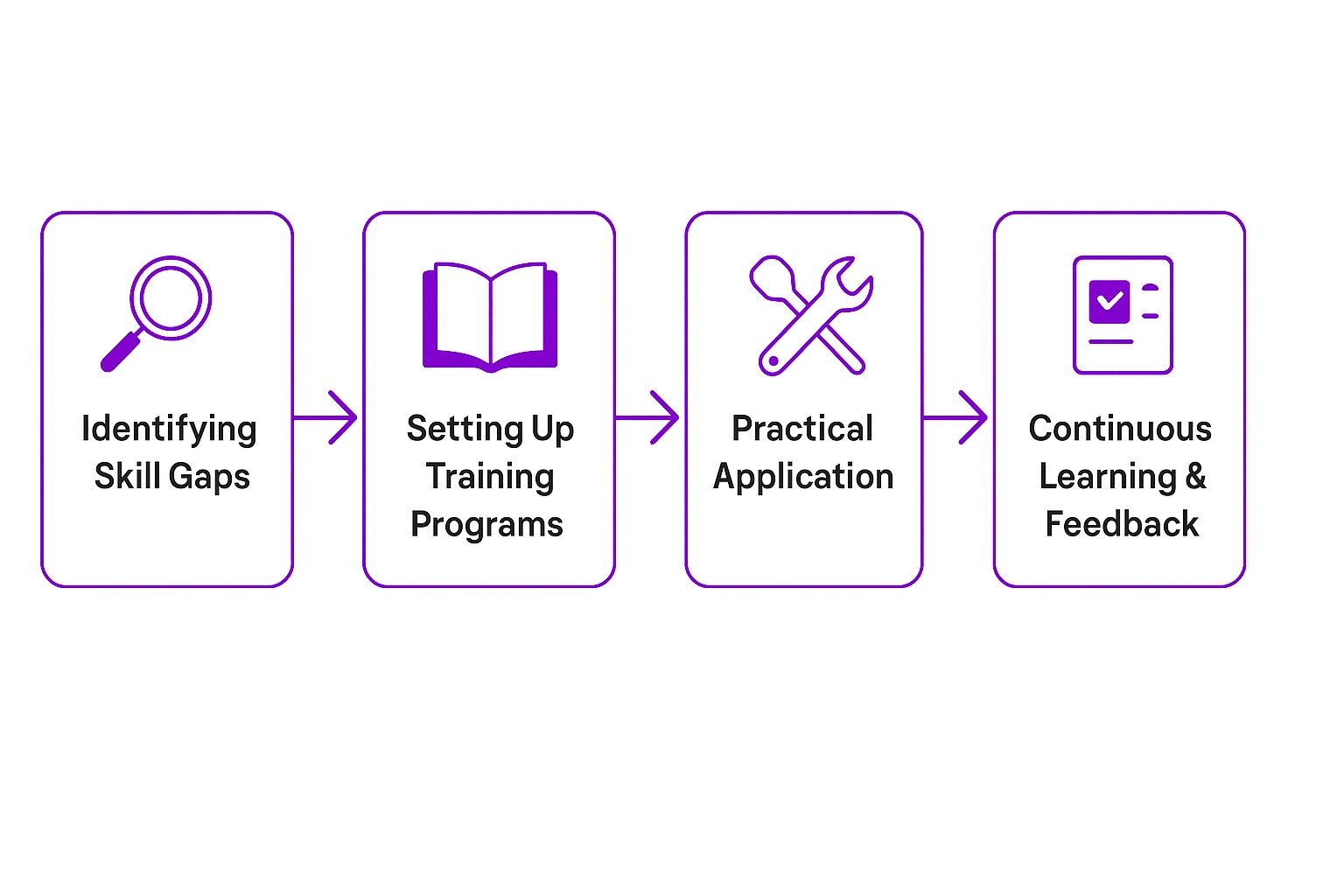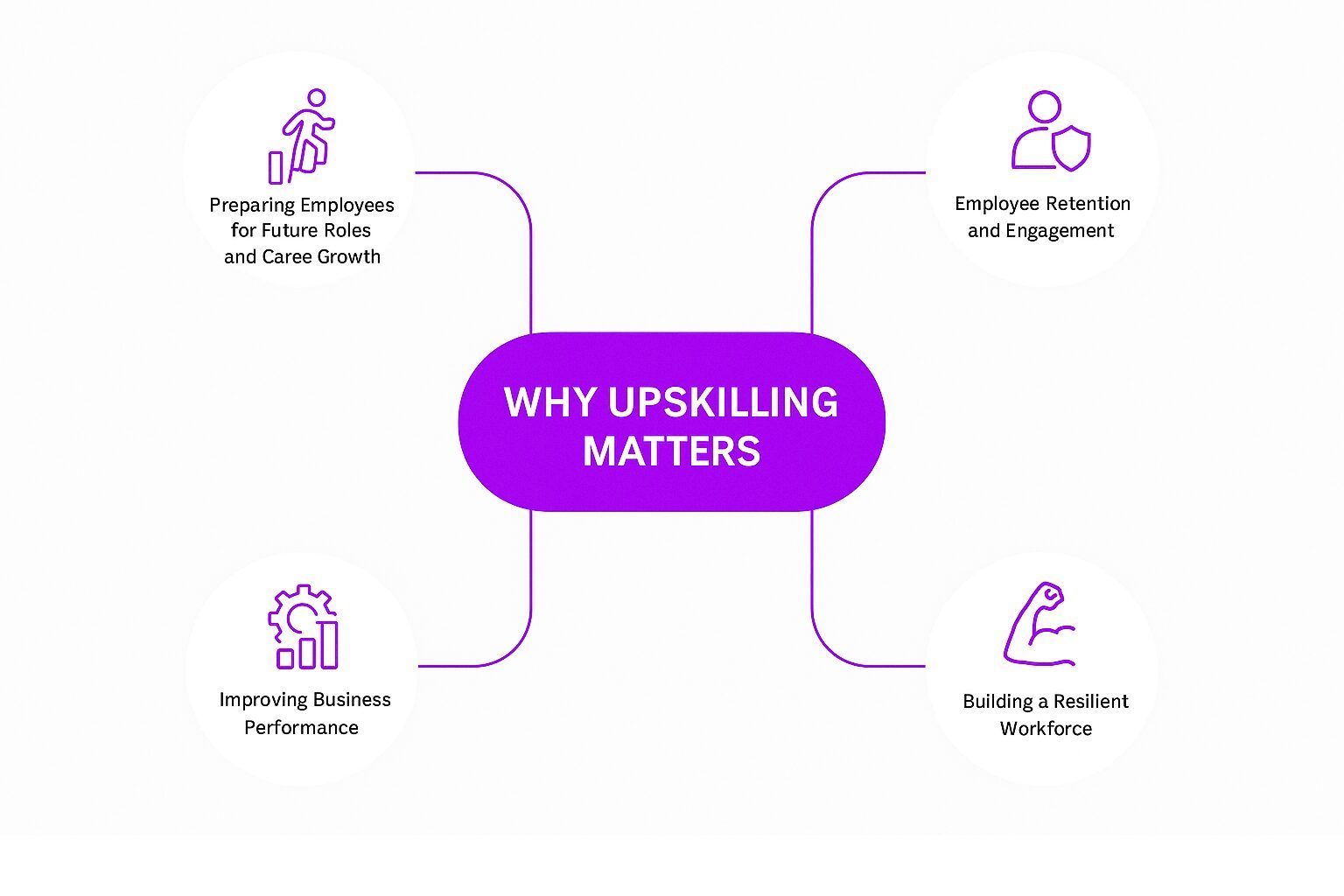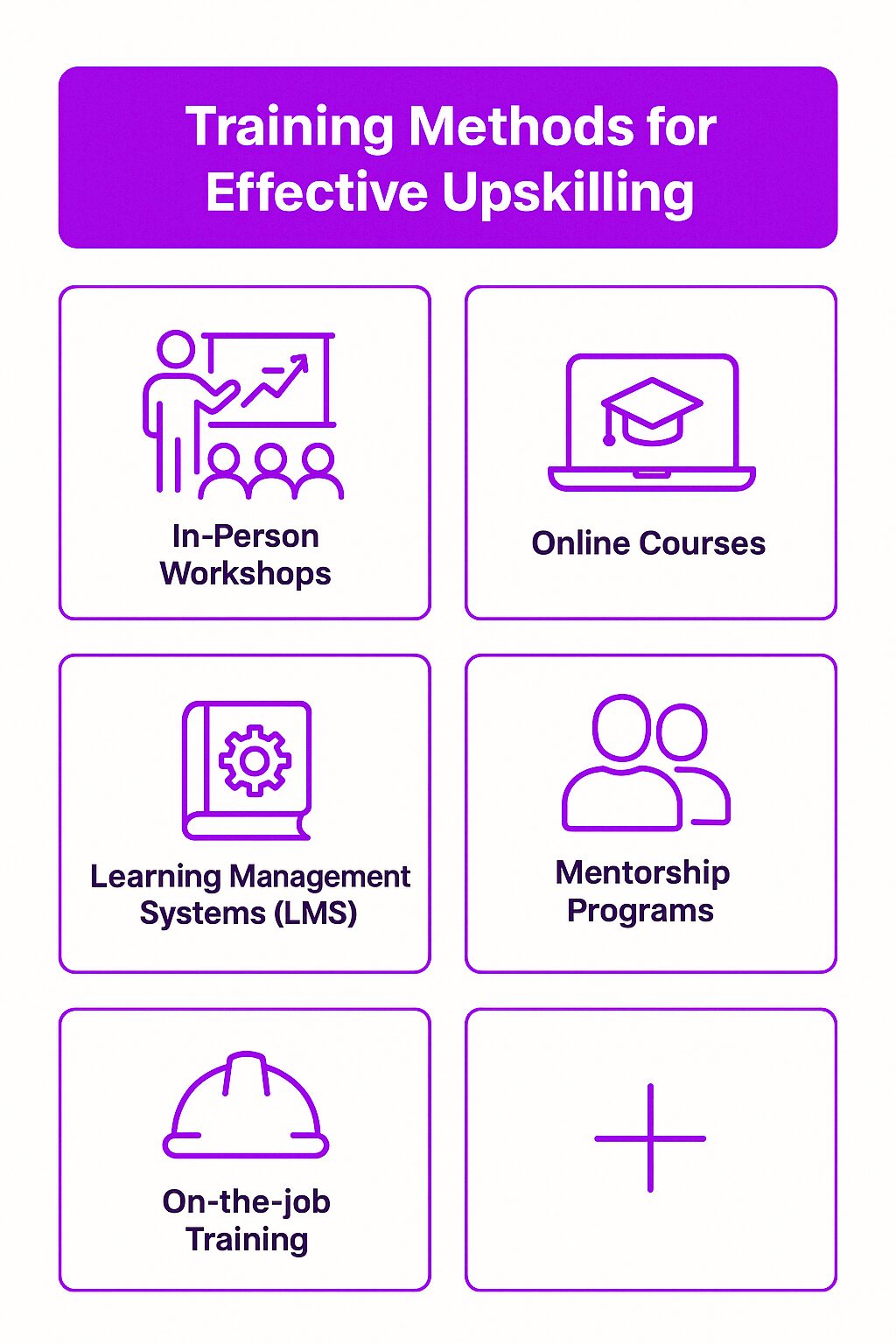Definition of Upskilling
Upskilling refers to the process of teaching current employees new skills or enhancing their existing skills to improve their job performance and ensure they stay relevant in an evolving workplace. It typically targets improving the abilities of workers in their current roles or preparing them for higher-level roles or responsibilities within an organization by acquiring advanced skills.
In a world where technology and processes are constantly evolving, upskilling is essential for both individuals and organizations to maintain competitiveness and achieve sustainable growth. Whether it’s learning to use new software, adopting updated methodologies, or developing soft skills such as leadership and communication, upskilling enables workers to advance in their careers and stay on top of industry demands.
Comprehensive Explanation of Upskilling
Skills employees acquire through upskilling are often initiated by the organization but can also be a self-driven effort by employees looking to enhance their career prospects. The key difference between upskilling and reskilling is that upskilling aims to expand an employee’s expertise within their current role or field, while reskilling involves training someone to perform a completely different job or role.
Why Upskilling Matters
As industries change, so do the skills required for different roles. Technological advances and shifting market demands often lead to skills becoming obsolete. Accurately identifying employee skills gaps is crucial to tailor learning and development initiatives, ensuring that employees can adapt and grow. For employees, this can mean stagnation in their career development or even job loss if they are not adaptable. For companies, a lack of upskilling initiatives can result in a workforce that is not equipped to meet future business needs or perform tasks efficiently.
For both employers and employees, upskilling is a proactive approach to overcoming these challenges. Employees gain greater job satisfaction and career growth opportunities, while businesses enhance their overall productivity, stay ahead of industry trends, and increase employee loyalty.
Key Stages/Components of Upskilling
1. Identifying Skill Gaps
The first step in any upskilling program is identifying what skills are needed. This often begins with a skills gap analysis, where the existing skills of employees are compared with the skills required to meet business objectives.
-
Assessments: Using employee surveys, performance reviews, and feedback from managers to identify areas where improvement is needed.
-
Future Skills: In addition to current gaps, it’s important to forecast future needs, considering industry trends and technological changes that might require new skills.
2. Setting Up Training Programs
Once skill gaps are identified, the next step is creating targeted training programs. This could include:
-
Internal Training: Developing in-house training sessions, such as workshops or lunch-and-learn sessions, that focus on specific skills or tools.
-
External Training: Partnering with educational institutions, online courses, or industry-specific certification programs to provide more structured and formal training.
These programs are designed to target specific areas where employees need development, such as technical skills, leadership abilities, communication techniques, or critical thinking.
3. Practical Application
To solidify learning, it’s crucial for employees to apply their new skills in real-world scenarios. This step often involves:
-
On-the-job Training: Allowing employees to practice what they’ve learned during their regular tasks.
-
Mentorship: Pairing employees with more experienced colleagues who can guide them as they apply their new skills.
-
Project Work: Assigning projects that require employees to use their new skills in practical settings.
4. Continuous Learning, Feedback, and Improvement
Upskilling is an ongoing process. Regular feedback helps to ensure employees are progressing and receiving the necessary support. This feedback might come from managers, peers, or self-assessments.
-
Tracking Progress: Using metrics like performance improvement, skill assessments, and employee engagement surveys to evaluate the success of upskilling programs.
-
Adjustments: Based on feedback, training methods or goals may need adjustment to better meet the needs of the employee and the organization.
Purpose and Importance of Upskilling
1. Preparing Employees for Future Roles and Career Growth
One of the primary goals of upskilling is to equip employees with the knowledge and abilities they need for future roles. By preparing them for higher responsibilities, companies create a talent pipeline that helps them maintain continuity when senior roles become vacant.
-
Succession Planning: Upskilling ensures that employees are ready to take on new challenges, which is particularly important for long-term sustainability.
2. Improving Business Performance
As employees gain new skills, they become more effective in their roles, leading to improved performance and productivity. Skilled workers are better equipped to handle changes in technology, processes, and customer expectations.
-
Competitive Edge: Organizations with highly skilled employees are better positioned to adapt to changes in the marketplace, which improves their ability to innovate and outperform competitors.
3. Employee Retention and Engagement
Investing in employees’ development through upskilling programs increases their job satisfaction and engagement. Employees who see that their company is invested in their growth are more likely to stay and remain motivated.
-
Employee Loyalty: Upskilling leads to a sense of value and recognition, which significantly reduces turnover rates.
4. Building a Resilient Workforce
The pace of change in today’s world is rapid. Upskilling helps employees adapt and stay relevant, ensuring that they don’t become obsolete. This is crucial for both individuals and companies that need to stay agile in a fluctuating economy.
Benefits of Upskilling
1. For Employees
-
Career Growth: Upskilling provides employees with the tools and knowledge to take on more advanced roles or move into different departments. This opens new career opportunities and increases job security.
-
Increased Confidence: Gaining new skills boosts employees’ confidence in their abilities, improving their job satisfaction.
-
Greater Job Satisfaction: Continuous development helps employees feel valued, which in turn increases their commitment and enthusiasm toward their work.
2. For Organizations
-
Higher Productivity: Employees with more skills tend to work faster and more effectively, leading to higher productivity and reduced error rates.
-
Cost Efficiency: Training current employees is often more cost-effective than hiring new staff. Upskilling can also reduce recruitment costs by filling roles internally.
-
Innovation: Upskilled employees bring new ideas and perspectives to the table, which can drive creativity and innovation in the workplace.
3. For the Economy
-
Workforce Competitiveness: A workforce with diverse and up-to-date skills is better able to adapt to the demands of a global economy.
-
Reduction in Skill Gaps: Upskilling initiatives help reduce the gap between the skills employers need and the skills available in the workforce, improving the labor market’s overall functionality.
Challenges of Upskilling
1. Resource Allocation
Investing in upskilling programs can be expensive, both in terms of time and money. Companies must allocate sufficient budget and time to ensure the programs are effective and worthwhile.
-
Training Costs: Companies may face significant costs when hiring external trainers or developing custom training programs.
-
Employee Time: Training requires time, and employees may need to balance learning with their daily responsibilities.
2. Resistance to Change
Not all employees are eager to embrace new skills. Resistance to change, especially when it comes to learning new technologies or ways of working, can hinder the success of upskilling efforts.
-
Overcoming Reluctance: Providing motivation and clear communication about the benefits of upskilling is necessary to overcome this challenge.
3. Measuring Effectiveness
It can be difficult to measure the success of upskilling programs. Tracking tangible results, such as improvements in productivity or employee satisfaction, requires well-defined metrics and ongoing assessment.
Practical Tips and Best Practices for Upskilling
1. Align Training with Business Goals
Ensure that your upskilling efforts align with the company’s long-term objectives. By focusing on skills that are critical to future business needs, you ensure that employees are prepared for challenges ahead.
2. Provide Flexible Learning Opportunities
Offer different learning methods to accommodate various learning styles. This might include:
-
In-person workshops for hands-on learners.
-
Online courses for remote employees or those with limited time.
-
Mentorship programs for personalized guidance.
3. Encourage a Growth Mindset
Foster a culture that values continuous learning. Promote the idea that learning is not only about improving job performance but also about personal development. This helps employees see upskilling as an opportunity for growth, not just a requirement.
4. Offer Incentives and Recognition
Reward employees for completing upskilling programs by offering incentives such as promotions, salary increases, or public recognition. This reinforces the importance of learning and helps motivate others to engage in the process.
5. Evaluate and Adapt the Program Regularly
Regularly assess the effectiveness of the upskilling program. Solicit feedback from employees, track performance changes, and adjust training methods to ensure the program continues to meet the needs of both employees and the organization.
Digital Skills Development
In today’s technology-driven world, digital skills development is a crucial aspect of upskilling. As industries increasingly rely on technology, acquiring digital skills such as data analysis, digital marketing, and software development is essential to stay competitive in the job market.
Training programs designed to enhance digital skills can take various forms, including online courses, workshops, and intensive boot camps. These programs provide employees with the opportunity to learn at their own pace and apply new knowledge in practical settings. Employers can further support digital skills development by offering on-the-job training and mentorship, ensuring that employees have the guidance and resources they need to succeed.
Investing in digital skills development is not only beneficial for career growth but also for professional development. As employees adapt to new technologies, they become more versatile and valuable to their organizations. This adaptability is key to staying relevant in a rapidly changing field and opens up new career paths and opportunities for advancement.
Utilizing a Variety of Training Methods
Effective upskilling and reskilling require utilizing a variety of training methods to cater to different learning styles. Different employees have different preferences and strengths when it comes to learning, so offering a range of training methods can help ensure that everyone receives the support they need.
Training methods can include traditional classroom training, which provides structured, face-to-face learning experiences. Online courses offer flexibility, allowing employees to learn at their own pace and access materials from anywhere. On-the-job training is another valuable method, enabling employees to apply new skills in real-world scenarios under the guidance of experienced colleagues. Mentorship programs provide personalized support and help employees navigate their career paths with the help of seasoned professionals.
Employers can also leverage a learning management system (LMS) to provide employees with access to a wide range of training materials and resources. An LMS allows employees to track their progress, revisit materials as needed, and complete training at their own pace. By utilizing a variety of training methods, employers can ensure that their upskilling and reskilling efforts are effective and inclusive, helping employees develop new skills and advance in their careers.
Evaluating the Impact of Upskilling
Evaluating the impact of upskilling is crucial to determine its effectiveness and identify areas for improvement. By assessing the outcomes of upskilling programs, employers can ensure that their efforts are aligned with business goals and are meeting the needs of their employees.
Various metrics can be used to evaluate the impact of upskilling, including employee engagement, retention rates, and productivity. These metrics provide insights into how well employees are adapting to new skills and how these skills are contributing to overall business performance. Additionally, evaluating upskilling programs can help identify skills gaps and areas where employees may need additional training.
Employers can use the results of their evaluations to refine their upskilling strategies, ensuring that training programs are continuously improved and remain relevant. This process of continuous learning and professional development is essential for adapting to the changing needs of both employees and the business. By regularly evaluating the impact of upskilling, employers can create a dynamic and responsive workforce that is well-equipped to meet future challenges.
Related Sub-concepts
Reskilling
Reskilling refers to the process of teaching employees entirely new skills to prepare them for different roles within the organization. Unlike upskilling, which focuses on improving existing skills, reskilling prepares employees for a career transition.
Cross-skilling
Cross-skilling involves teaching employees skills that are outside of their normal job role but still within the broader scope of the organization. This helps employees become more versatile and better equipped to handle a wider range of tasks.
Real-World Examples and Use Cases
Microsoft’s Upskilling Programs
Microsoft has invested significantly in upskilling, offering programs for both their employees and the broader community. Through the Microsoft Learn platform, they provide training in various tech fields, including cloud computing and artificial intelligence.
Amazon’s Upskilling Initiative
Amazon has been a leader in workforce development, offering Upskilling Education programs that help employees transition into higher-paying roles within the company. This includes funding for college degrees and certification programs in areas such as IT and business management.
Deloitte’s Upskilling Programs
Deloitte’s upskilling efforts focus on providing employees with the skills necessary to stay ahead in a rapidly changing business world. By offering access to learning platforms, online courses, and workshops, Deloitte ensures its workforce is prepared for new challenges.







